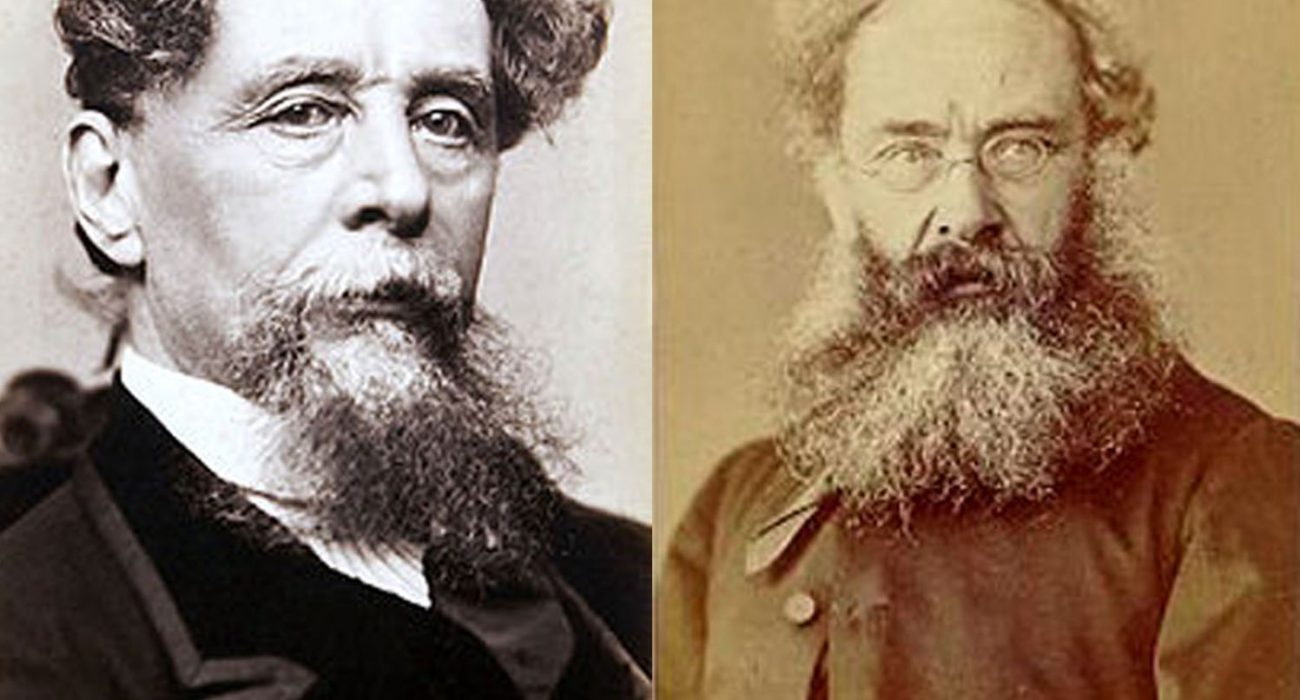In “The Dreams of Mrs. Flintwinch thicken,” a short chapter of Charles Dickens’ Little Dorrit (1857), the kind-hearted Arthur Clennam visits his childhood home. “Oppressive secrets” pervade the crumbling house and its London neighborhood. The night engulfs Clennam in a sense of ominous mystery. At the door he finds a stranger, a man he’s observed before and judged an unsavory character. Clennam’s mother admits the stranger and prepares to discuss some business with him, while coldly dismissing Clennam from the house. As he leaves, the bewildered son turns to his old friend the housekeeper. “For Heaven’s sake, Affery,” he pleads, “what is going on here?”
Clennam speaks for the reader of this and countless other scenes in Dickens’ novels. Time after time, unnamed characters materialize, engage in some cryptic dialogue or shadowy deed, then vanish for a hundred or more pages. When they resurface, identified by an odd facial feature or quirky article of clothing, the mystery of what they’re doing in the story resumes. Such confusion is the fundamental Dickens reading experience. It’s why your ninth-grade introduction to the novelist consisted largely of the teacher writing characters’ names on the blackboard, sorting out who does what and who’s related to whom. It’s why one paperback edition of Little Dorrit contains an appendix that summarizes the tangled events preceding the main action.
Only after doggedly figuring out what’s going on can we step outside the reading experience, and try to characterize Dickens. Abstracted from the immediate texture of his books, he’s the champion of the urban poor and an advocate for the underdog: children, the disinherited, the forgotten, the oppressed. Meanwhile noblemen, bureaucrats, tycoons, and socialites come in for Dickens’ withering, ironic satire. His portrayals of homeless waifs can be mawkish and manipulative, but no one goes after social injustice like Dickens.
Anthony Trollope, Dickens’ fellow bestselling novelist, seems by contrast the complacent chronicler of the status quo. Millions know Trollope through the 26 episodes of the 1974 BBC series The Pallisers, about fabulously wealthy aristocrats. (Dickens’ most memorable screen moment might be a boy holding out an empty bowl, asking for more.) While Dickens characters skulk through murky London streets, Trollope’s squires, earls, and dukes, with their haughty dames, receive friends at their country estates. Every now and then they stir themselves on behalf of the local fox population.
When we place the two novelists side by side in this way, Dickens looks like the challenging, subversive one, keeping readers off balance and scourging the powers that be, while Trollope tells stories that soothe his audience and confirm its conventional views. In fact, however, Dickens’ habit of puzzling the reader anticipates a lit-crit orthodoxy that’s plenty elitist in its own right, and his sneering satire often amounts to a retreat from the world, rather than a grappling with its ills. Trollope might have a weakness for sappy, repetitive love stories, but his quiet realism has a probing, tough-minded side that comes out in the moral predicaments he explores. (There’s a reason, besides its brevity, that The Warden (1855) has been a teaching standby.) The contrast between Dickens the dazzling showman and Trollope the pragmatic realist appears starkly in the ways they present their characters.
***
He offers them not as real people but as fabrications, proof of his endless originality. Before anything else he’s putting on a show, putting his powers of imagination on display.
In his posthumously published Autobiography (1883), Trollope dismisses Dickens’ characters as “puppets” who bear no resemblance to “human beings.” Many Trollope fans would probably agree, citing Dickens’ habit of assigning to each new arrival some special body part, mannerism, or verbal tic, and leaving characterization at that. Often their names help cement his characters’ defining traits: Mrs. Gamp, Mr. Pecksniff, Uriah Heep, Harold Skimpole. Another essential quality of puppets, however, besides their psychological flatness, is that they’re cleverly constructed. They rivet viewers precisely because their blatant artifice renders them weirdly inhuman. To complain about the inhumanity of Dickens’ characters, then, might well be to miss the point. He offers them not as real people but as fabrications, proof of his endless originality. Before anything else he’s putting on a show, putting his powers of imagination on display.
Secrecy and mystery enhance the show. Dickens won’t use a straightforward narrative to elucidate what’s going on–because where’s the art and the resourcefulness in that? Instead he maneuvers characters in and out of scenes and amasses picturesque details, deferring explanations as to what it all might mean. At the end, in a flurry of discoveries, the grand design is revealed.
For his part, Trollope scorns mystery as completely as Dickens shuns directness. Not only does Trollope relate events in an intelligible linear sequence, writing in a plainspoken — some would say commonplace — style, but when a plot juncture threatens to create suspense, he hastens to clear up what’s going on. “But let the gentle-hearted reader be under no apprehension whatsoever,” he writes at a perilous moment in Barchester Towers (1857). “It is not destined that Eleanor shall marry Mr. Slope or Bertie Stanhope.” In Phineas Redux (1874), when all the evidence points to our hero having committed a murder, Trollope again reassures us: “The reader need hardly be told that, as regards this great offence, Phineas Finn was as white as snow. The maintenance of any doubt on that matter–were it even desirable to maintain a doubt–would be altogether beyond the power of the present writer.” Why does Trollope insist on giving his secrets away? Why not build, like Dickens, toward a big revelation?
As he implies with his remark that the reader “need hardly be told” that Phineas is innocent, Trollope believes that most “mysteries” aren’t mysterious at all. He’s like those whodunit detectives who claim to use “psychology”–before reverting to the usual rigmarole of footprints and locked doors. Trollope really does think character dispels mystery. In Barchester Towers, when Francis Arabin fears that Eleanor Bold will accept the loathsome cleric Mr. Slope, Trollope asserts concerning Arabin, “He should have known her well enough to feel that it was truly impossible. He should have been aware that Eleanor had that within her which would surely protect her from such degradation.” For Trollope, mysteries exist only in a world of puppets. If people really know and understand one another, they won’t find each other’s actions perplexing.
With his guarantee that Eleanor won’t marry Mr. Slope, Trollope foregoes mystery to concentrate on character. Eleanor’s friends and family have mistaken her scrupulous fairness toward Slope for a romantic inclination, and they decide she must be engaged to him. Knowing Eleanor’s true state of mind, we feel her loneliness. She suffers the humiliation of an unjust charge, but, worse, she discovers that the people she loves fail to know and understand her. Up to this point, Eleanor Bold has been one of Trollope’s less memorable heroines, but in her distress and isolation she becomes a sharply etched character.
Phineas Finn undergoes a similar ordeal. Innocent, as Trollope has assured us, of murdering his rival Mr. Bonteen, Phineas tortures himself with thoughts not of his near-certain hanging but of the people who don’t believe in him. “Could it be that even his dearest friends thought it possible that he had been guilty?” he asks himself. Even when he’s acquitted and, more importantly, proven innocent before the world, he can’t immediately resume his former life. What would be called in the next century his “social self” has disintegrated, and he remains shattered until his friends coax him back into their midst.
Trollope could easily have prolonged the mysteries regarding Eleanor’s affections and Phineas’ supposed guilt, stoking readers’ uncertainty and dread. Instead he immediately confides the facts, and asks what they mean for his characters. Eleanor will never marry Mr. Slope–how then does she feel when everyone believes she will? Phineas did not kill Mr. Bonteen–how can he bear his former associates believing he’s a murderer? Putting such questions at the center of his fiction, Trollope deals not in enigmas and dramatic disclosures, but in patient, steady illumination.
***
Nathaniel Hawthorne and Virginia Woolf famously admired Trollope’s characters. They’re like people a giant examines under a glass case, marveled Hawthorne. They’re as real as our weekly bills, murmured Woolf. Recall Hawthorne’s and Woolf’s own fiction, however, and their flattery doesn’t pass the imitation test. They don’t patronize Trollope with the superciliousness of a Henry James (who said Trollope handles his brush with a “large-fisted grip”), but their work implies that, while humble realism and life-like characters are all very well, the highest art requires imagination and refined consciousness.
For all his sympathy toward downtrodden nobodies, Dickens subscribes to the art aristocracy where Hawthorne, James, and Woolf reside. He personifies, albeit in embryonic form, the modernist dogmas that later ruled literature and criticism. It’s a short hop, after all, from making the reader ask “What’s going on?” to exhorting a creative writing class to “Show, don’t tell.” It isn’t far from a series of disconnected scenes to the complete purging of authorial voice. With his elaborate mysteries, showy set pieces, and “original” (i.e. grotesque) characters, Dickens promotes the novelist’s role not as imitator of life but as artful fabulist, perched high above mundane realities.
Trollope, meanwhile, works within what Emerson calls, in “Experience,” “the actual horizon of human life.” For Trollope, society and its institutions aren’t (or at least aren’t solely) occasions for brilliant satirical excursions. They’re the ordinary–and the only–means of getting things done. Where Dickens creates Jarndyce and Jarndyce, the monstrous Bleak House lawsuit that devours anyone who strays within its reach, Trollope offers characters who navigate the legal system in the course of fulfilling their duties. In Doctor Thorne (1858), for example, a physician masters a convoluted inheritance case so that his niece can marry her cash-strapped beau. Where Dickens bludgeons politics in a chapter of Little Dorrit called “Containing the whole Science of Government” (featuring the workings of the Circumlocution Office), Trollope depicts in his Palliser novels the ways representative government actually works, despite its hypocrisy and shortcomings. Throughout his fiction he takes flawed human beings and imperfect arrangements for granted, and he makes them the material for his stories.
***
He never lets us forget the strangeness of art.
In Little Dorrit, Arthur Clennam pays repeated visits to the Circumlocution Office, only to find himself cooling his heels “in a hall, a glass case, a waiting room, and a fire-proof passage where the department seemed to keep its wind.” In thousands of pages of Trollope you won’t find anything as bracingly odd as that. Nor will you find a scene as devastating as the dinner party where William Dorrit’s mind throws him back to the Marshalsea Prison, or as eerie as Miss Havisham’s frozen wedding tableau. Dickens is the master of the startling insight, the bravura extended metaphor, the unexpectedly delicious phrase. He never lets us forget the strangeness of art.
Trollope’s art feels uncanny in a different way. Spending time with his characters is like standing before a nineteenth-century portrait painting–one of those hatted, crinolined matrons who ought to seem remote, but who instead meets your eye with a confiding smile. Muffled in her dignified layers, she loves the things you love, fears the things you fear, has her cherished memories and her furtive hopes. Trollope’s Glencora Palliser inhabits the same distant century, and on top of that possesses enormous riches and a lofty rank. Yet she seems as real as those weekly bills, much realer than our comic-book movies and “reality” TV. By the fourth or fifth Palliser novel, her generous acts and well-intentioned follies–scheming to clear Phineas Finn of the murder charge, running a social ministry parallel to her husband’s fragile government–seem like those of a mischievous friend. Her speech sounds natural, unmistakably hers. When she and the Duke talk, you almost forget you’re reading a book. The Pallisers spring not from untrammeled invention but from an imagination tempered to the world as it is, peopled with adults who accept its conditions and embrace its abundant gifts.






1 comment
Brian
Isn’t much of this because Dickens wrote in serial form?
Comments are closed.